| |
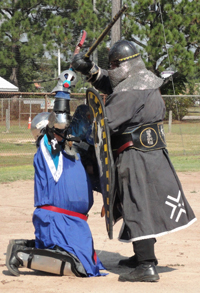 |
What is the SCA?
The Society for Creative Anachronism, or SCA,
is an international organization dedicated to
researching and re-creating the arts, skills, and traditions
of pre-17th-century Europe.
Members of the SCA study and take part in a variety of activities including archers, calligraphers, heralds, fencers, spinners, blacksmiths, costumers, dancers, cooks and armoured fighters. We enjoy feasting, spinning, needlepoint, equestrian, leatherwork, beadwork, socializing, live weapons competition, period music, theatre and much more. If it was done in the Middle Ages or Renaissance, you can bet someone is trying to do it now.
What makes the SCA different from a Humanities 101 class is
the active participation in the learning process.
To learn about the clothing of the period, you research it, then sew and wear it yourself.
To learn about combat, you put on armor (which you may have built yourself)
and learn how to defeat your opponent.
To learn cooking, you make (and sample!) your own meals, desserts, and subtleties.
The goal is to learn through doing. Doing and sharing ones subject knowledge with others. The SCA encourages historical research and recreation, and most importantly: preserving a code of conduct, mentality and philosophy that, in many ways, is lacking in the modern world.
You will frequently hear SCA participants describe the SCA as recreating the Middle Ages "as they ought to have been." In some ways this is true – we choose to use indoor plumbing, heated halls, and sewing machines. In the dead of winter we have more to eat than King's venison, salt pork and dried tubers. However, a better description is that we selectively recreate the culture, choosing elements of the culture that interest and attract us. |
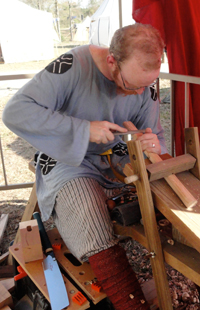 |
| |
|
|
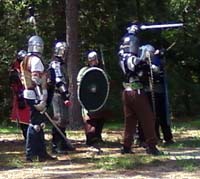
|
Fighting in the SCA, or
Why are those people hitting each other?
Armored combat in the SCA resembles medieval foot tournaments. Combatants can face each other in single combat in tournaments, or can take part in large melee battles that can have dozens or even hundreds of combatants on each side.
Since we prefer that no one gets hurt, SCA combatants wear real armor and use rattan swords. Rattan, which looks like bamboo but has a solid core, is springy enough to absorb some of the force of the blow without snapping, and light enough to approximate the weight of a steel sword. Swords are constructed by wrapping a yard-long piece of rattan in duct tape and attaching a hilt. Building armor is much more complex – a complete suit has many parts, which can be made from hammered steel, rivets, leather, even rigid plastic (if well-disguised). Some pieces of armor can take many, many hours to construct.
Novice fighters are trained by the more experienced fighters. They are taught how to use their weapons, how to defend themselves, and how to judge blows received in combat. Every fighter on the field is on his/her honor to accept a blow sufficient to "wound" or "kill". At the end of training, if the marshals (our safety officers) decide that the fighter is safe – not necessarily good, but unlikely to hurt him or herself or an opponent – then the fighter is considered authorized to fight. The process of becoming authorized can take from a few weeks to several months.
Another type of SCA combat is fencing, also known as rapier combat. Participants use real blades and for protection they wear regulation fencing masks, padded torso protection, and shirts and pants made from heavy fabric to protect their limbs. Unlike modern fencing, SCA fencing is done "in-the-round", and combatants can fight in close with their opponents. Blows are acknowledged by the recipient (as in armored combat), not by a set of judges. Fencers can face each other one-on-one in tournaments, or in large melee battles with dozens or even hundreds on a side.
SCA fencing has its own set of marshals who supervise the authorization process. New fencers must demonstrate their knowledge of the rules and ability to participate safely before they can compete in tournaments.
In all SCA combat, safety is the most important consideration. There are armor requirements and rules which all participants must follow. Before combat begins, the marshals inspect the combatants' equipment to make sure they are safe. During the battles, the marshals watch for unsafe situations and keep spectators safe.
back to top |

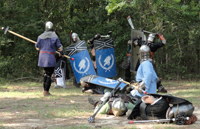
|
| |
|
|
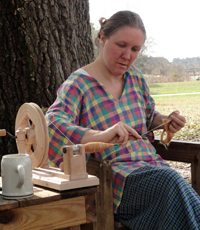

|
Arts & Sciences in the SCA,
or What is he making over there?
It doesn't matter if your desire is to master a craft, or just dabble...
If they did it "then", more than likely you'll be able to find someone doing it now.
Learn leatherwork, and you can make footwear, pouches and armour. Take up embroidery, and you can decorate garments, accessories, tapestries, purses, coifs, and so on. Bang on metal and turn out armour, silverwear, jewlry, etc... and metalworking, pewter-casting, and enameling can create brooches, rings, belt-buckles, and other such things. Knitting can create stockings and caps (as can knitting's Viking-era ancestor, nalbinding); lampworking can create lovely beads for necklaces.
There's also pottery, painting, weaving, storytelling, leathercraft, games, woodworking, spinning, making maile, candlemaking, poetry, acting, soapmaking and much, much more.
Like the rest of the SCA, the goal is to learn through doing.
Your group's Arts & Sciences officer can help you find local workshops and
may be able to provide you with some guidance in terms of
researching and learning these and other medieval arts, crafts and games.
back to top |
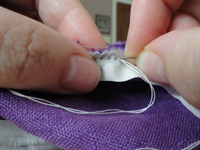
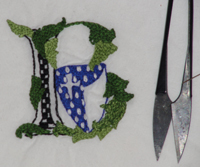
|
| |
|
|
| |
What kind of person joins the SCA?
SCA participants are just plain folks who enjoy doing something more with their weekends.
People from all walks of life join the SCA – students, teachers, historians, writers, secretaries, law enforcement personnel, chemists, and insurance agents.
Many SCA participants are involved in high tech fields – computers, aerospace, high energy physics, etc. People who spend all week with highly complex, modern technology can find it relaxing to spend their leisure time using simpler technologies in a less modern setting.
How you can get involved
We welcome you to come to our local meetings and events. You are not required to buy a membership before you start attending, although you may wish to join if you decide to be with us regularly. Members do pay lower entry fees to events, and some kingdoms require membership to participate in certain activities.
Many local groups have officers called "chatelaines" whose sole duty is to help new members find their way in the SCA, and they can provide you with loaner costumes for your first event.
Each SCA participant remembers the day he or she started,
and most people are happy to help out a newcomer. |
|
|










